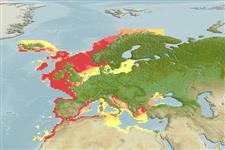Common names from other countries
Elasmobranchi (squali e razze) (sharks and rays) >
Rajiformes (Skates and rays) >
Rajidae (Skates)
Etymology: Leucoraja: Greek, leykos = white + Latin, raja = a fish, Raja sp. (Ref. 45335).
More on author: Linnaeus.
Environment: milieu / climate zone / distribuzione batimetrica / distribution range
Ecologia
marino batidemersale; distribuzione batimetrica 30 - 600 m (Ref. 106604). Deep-water; 72°N - 27°N, 24°W - 34°E
Eastern Atlantic: Murmansk in Russia, Norway, southern Iceland, the Faroes, northern North Sea and Skagerrak to northern Morocco, including western Mediterranean and the Madeira Islands.
Length at first maturity / Size / Peso / Age
Maturità: Lm ?, range 75 - ? cm
Max length : 120 cm TL maschio/sesso non determinato; (Ref. 106604); 111.0 cm TL (female)
Spine dorsali (totale) : 0; Spine anali: 0. Snout pronounced, rather pointed; disc rhomboid, with angled outer corners upper surface entirely spinulose, underside prickly on large areas; about 8 thorns usually in a complete row around inner margin of eye, small thorns on scapular, generally a row of about 50 thorns on each side of midline from shoulder to first dorsal fin; upper surface plain ashy-grey, underside white (Ref. 3167).
Body shape (shape guide): other; Cross section: flattened.
Found in relatively cold coastal waters and on upper parts of continental slopes (Ref. 3167). Most common at depths of around 200 m, but deeper in southern areas (Ref. 3167); possibly down to 800 m (Ref. 131089). Feed on all kinds of bottom animals, probably preferring fish (Ref. 3167). Oviparous. Distinct pairing with embrace. Young may tend to follow large objects, such as their mother (Ref. 205). Eggs are oblong capsules with stiff pointed horns at the corners deposited in sandy or muddy flats (Ref. 205). Egg capsules are 7.5-9.9 cm long and 4.5-4.7 cm wide (Ref. 41250). Maximum length for female is 111 cm (Ref. 41333).
Life cycle and mating behavior
Maturità | Riproduzione | Deposizione | Uova | Fecundity | Larve
Oviparous, paired eggs are laid. Embryos feed solely on yolk (Ref. 50449). Distinct pairing with embrace. Young may tend to follow large objects, such as their mother (Ref. 205).
McEachran, J.D. and K.A. Dunn, 1998. Phylogenetic analysis of skates, a morphologically conservative clade of elasmobranchs (Chondrichthyes: Rajidae). Copeia 1998(2):271-290. (Ref. 27314)
IUCN Red List Status (Ref. 130435: Version 2025-1)
Threat to humans
Harmless
Human uses
Pesca: scarso interesse commerciale
Strumenti
Special reports
Download XML
Fonti Internet
Estimates based on models
Preferred temperature (Fonte Biblio.
123201): 6.8 - 14.5, mean 9.5 °C (based on 370 cells).
Phylogenetic diversity index (Fonte Biblio.
82804): PD
50 = 0.5000 [Uniqueness, from 0.5 = low to 2.0 = high].
Bayesian length-weight: a=0.00339 (0.00168 - 0.00685), b=3.25 (3.08 - 3.42), in cm total length, based on LWR estimates for this Genus-body shape (Ref.
93245).
Trophic level (Fonte Biblio.
69278): 3.5 ±0.37 se; based on food items.
Resilienza (Fonte Biblio.
120179): Basso, tempo minimo di raddoppiamento della popolazione 4.5 - 14 anni (Assuming tm>5).
Fishing Vulnerability (Ref.
59153): High to very high vulnerability (72 of 100).
🛈
Climate Vulnerability (Ref.
125649): Moderate vulnerability (38 of 100).
🛈
Nutrients (Ref.
124155): Calcium = 3.69 [0.55, 69.61] mg/100g; Iron = 0.283 [0.028, 3.709] mg/100g; Protein = 15.3 [13.2, 17.3] %; Omega3 = 0.379 [0.153, 0.945] g/100g; Selenium = 16.4 [3.0, 77.0] μg/100g; VitaminA = 3.67 [0.27, 48.17] μg/100g; Zinc = 0.269 [0.018, 3.165] mg/100g (wet weight);
